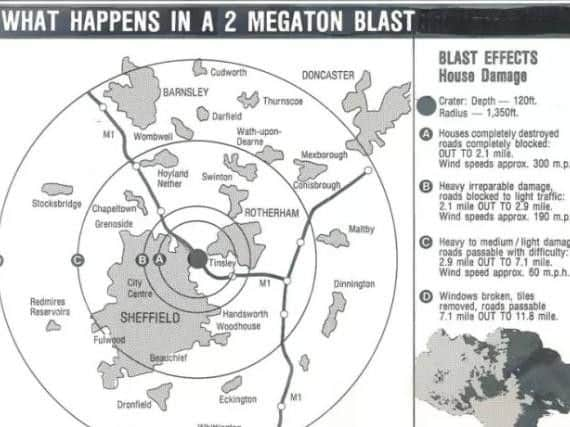What would happen if Sheffield was nuked?
and live on Freeview channel 276
Over the years, there have been a number of studies on what would happen in the event of a devastating atomic bomb blast on the city.
And it has been revealed that the city was on a list of possible Russian targets drawn up at the height of the Cold War.


Advertisement
Hide AdAdvertisement
Hide AdThe piece focused on a ‘nuclear family’ in Sheffield and what they and other families like them would need to do in order to survive an atom bomb on the city.
A popular BBC drama, Threads, released in 1984 posed the same question: what would happen to the city in a nuclear event?
Shot on a budget of just £250,000, the film used several Sheffield locations including Sheffield Royal Infirmary and the since-imploded Tinsley Towers.


According to our archives, this graphic was drawn up in 1981, at the peak of the Cold War, in which a nuclear attack on Sheffield - a centre of industry - was thought to be a very real threat.
Advertisement
Hide AdAdvertisement
Hide AdThe feature shows the centrepoint being Tinsley - where the factories are - with the immediate blast radius destroying everything in its path, letting loose 300mph winds.
Everything in zone A and B in the photo above would be smashed, in zone A around Tinsley and Attercliffe, 300pmh winds would destroy homes completely and block roads.
In zone B, the city centre, there would be 190mph winds and heavy irreparable damage to houses, including most of Rotherham.
Zone C would cover most of the outskirts of the city on the other side, with heavy to medium damage to houses. Roads would be passable with some difficulty.
Advertisement
Hide AdAdvertisement
Hide AdFinally, zone D, covering Barnsley, Mexborough and Derbyshire, would have windows broken and damaged tiles etc, but otherwise would escape relatively unscathed.
Even in the areas where you might be OK - like Chesterfield and Doncaster - radiation would then spread across all of South Yorkshire, depending on wind direction.
Meanwhile, more recently, it was revealed that 20,000 people would be killed if a hydrogen bomb hit the city.
The computer programme, Nukemap, predicted 20,010 fatalities and 43,660 injuries – if a bomb with a yield of 10 kilotons, was dropped on Sheffield.
Advertisement
Hide AdAdvertisement
Hide AdIf, in the unlikely event the bomb was dropped in the city centre, the radius of the nuclear fireball would reach a diameter of 0.12 kilometres causing fatalities, taking out the city centre and many of the city’s landmarks including The Town Hall.
The results of the computer programme show that the aftermath of the blast would be similar to Threads.
The air blast radius would reach as up to 0.69 kilometres meaning stretching out towards St Mary’s Gate and Netherthorpe Road.
The pressure of the blast in this area would cause most buildings to collapse and widespread fatalities.
Advertisement
Hide AdAdvertisement
Hide AdRadiation would reach almost five kilometres and without medical treatment, there can be would be between 50 per cent and 90 per cent mortality from acute effects alone.
Dying would take between several hours and several weeks.
People more than 6 kilometres away would suffer third degree burns.
Areas such as Broomhall, Upperthorpe, Highfield and parts of Sharrow would be affected.
